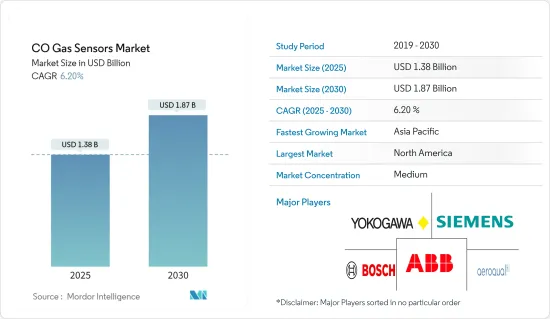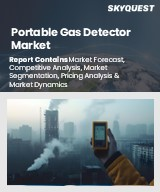
|
시장보고서
상품코드
1640377
CO 가스센서 - 시장 점유율 분석, 산업 동향 및 통계, 성장 예측(2025-2030년)CO Gas Sensors - Market Share Analysis, Industry Trends & Statistics, Growth Forecasts (2025 - 2030) |
||||||
CO 가스센서 시장 규모는 2025년에 13억 8,000만 달러로 추정됩니다. 2030년에는 18억 7,000만 달러에 이를 것으로 예측되며, 예측 기간의 CAGR은 6.2%를 나타낼 것으로 예상됩니다.

산업에는 다양한 용도가 있으며, CO 가스를 공정 관련 작업에 사용하는 산업도 있고, 제품별로 방출하는 부문도 있습니다. 안전한 작업 환경을 확보하고 작업자의 생명과 관련된 노출을 피하기 위해 산업은 엄격한 규제를 준수합니다. 이러한 규제는 CO 가스 경보기와 감지기를 높은 속도로 조기에 도입하는 데 매우 중요합니다. 이러한 이유로 산업에서 CO 가스센서 수요 증가에 직접적인 영향을 미치고 있습니다.
이 센서는 CO 가스 수준이 위험한 농도로 상승할 때 조기 경고를 제공함으로써 인명을 보호하는 데 중요한 역할을 합니다. 이 센서는 사람들에게 잠재적 위험을 경고하고 CO 가스 중독과 사망 사고를 예방하여 신속한 대피 및 개입을 가능하게 합니다.
직장 안전을 보장하기 위한 정부 규제는 주로 CO 가스센서 시장의 성장을 높이고 있습니다. 예를 들어, 영국, 독일, 프랑스는 위험한 가스가 대기 중으로 방출되는 것을 피하기 위해 다양한 규칙을 시행합니다. 화학공업가스는 인화점이 낮고 폭발하는 데 한계(LEL)가 있어 가연성/연소성 스펙트럼이 넓습니다. 이러한 가스로 인한 위험은 이러한 가스 센서와 모니터를 지속적으로 사용하여 최소화할 수 있습니다.
또한 IIoT는 다양한 지역에서 진행되고 있습니다. 고객은 IoT CO 가스센서에 대한 관심을 높이고 있으며, 기업 진출기업은 IoT 솔루션에 맞는 제품 범위를 시작하기 위해 노력하고 있습니다. 상시 실시간 모니터링 및 배출가스 검지의 필요성으로 인해 무선 센서가 필요하며 향후 수년간 CO 가스센서 수요를 끌어올릴 것으로 예상됩니다.
또한 제품의 소형화로 휴대용 유연성을 제공하는 휴대용 가스센서 장치가 개발되었습니다. 이러한 산업에서는 자동화를 채택하고 모든 데이터를 수집하는 것이 중요합니다. 이러한 요건으로 양방향 통신 기능을 갖춘 무선 센서에 대한 수요가 증가하고 있습니다.
그러나 규제 요건이 없기 때문에 이러한 센서를 채택하는 긴급성이 떨어지고 시장 성장이 제한됩니다. CO 가스센서는 크게 개선되었지만 기술적 한계도 있습니다. 예를 들어, 일부 센서는 낮은 수준의 CO 가스를 검출하기 어렵고 수명이 제한되어 빈번한 교정이 필요합니다. 이러한 기술적 한계가 CO 가스센서 시장의 방해가 될 것으로 예상됩니다.
또한 러시아와 우크라이나 전쟁은 센서를 포함한 반도체 및 전자 부품을 생산하기 위한 원료의 중요한 공급업체인 반도체 및 전자 부품공급 체인에 영향을 미치고 있습니다. 분쟁은 공급망을 혼란스럽게 하고 이러한 재료의 부족과 가격 상승을 일으키고 CO 가스센서 제조업체에 영향을 주며 최종 사용자의 비용 상승으로 이어질 수 있습니다.
CO 가스센서 시장 동향
석유화학 부문이 성장을 견인
- CO 가스센서는 LPG 및 LNG 부문에서 빠르게 도입이 진행되고 있습니다. 이러한 산업에서는 가스 저장, 생산, 운송의 각 단계에서 점검이 필요하기 때문입니다. 또한 천연가스 생산이 세계적으로 증가하는 반면 처리시설의 안전성과 보안에 대한 수요도 증가하고 있습니다. MOSPI에 따르면 같은 해 인도의 총 에너지 소비량의 37%를 석유화학이 차지하고 있습니다.
- 현재 TWA는 불과 5,000ppm이며 이산화탄소는 공기의 두 배 이상 무겁습니다. 현재 IDLH의 4체적%에 해당하는 4만ppm이 사용되고 있습니다. 독성 노출 증상은 두통, 호흡 곤란, 심박수 증가, 경련입니다.
- 석유화학산업에서는 석유회수나 요소·메탄올 생산에 있어서 CO2농도를 연속적으로 검지하고 가스가 유독한 양이 되면 상시 알람 지령을 발하는 센서에 의한 CO2가스 모니터링이 필요합니다.
- 또한 가스 누출 감지 및 공기 품질 모니터링에도 사용됩니다. CO 가스센서는 적외선 이미저 및 적외선 카메라와 같은 다른 장비와 함께 사용하여 가스 누출의 원인을 파악하는 데 도움이 됩니다.
북미가 큰 시장 점유율을 차지할 전망
- 이 지역은 시장 성장에 크게 투자하고 있습니다. 산업안전대책 증가, 산업분야에서의 용도 증가, 지역 전체의 CO 가스에 의한 사망자수 증가가 CO 가스센서 수요를 더욱 높여지고 있습니다.
- 또한 온타리오주 소방서장 협회에 따르면 캐나다 전역에서 연간 50명 이상이 CO 중독으로 사망하고 있습니다. 사람들은 겨울에 따뜻하게 하기 위해 연료 연소기구를 사용하는 경우가 많으며 사망의 주요 원인은 추운 기상 조건입니다. 따라서 CO 가스센서를 도입하는 것이 유익합니다. 이러한 전자 제품은 모르는 사이에 위험한 수준의 CO 가스를 가정에 축적시킬 수 있기 때문입니다. CO 가스센서는 주로 CO 가스 감지기 및 경보기에 사용됩니다.
- IEA의 Annual Energy Outlook 2022에 따르면 미국은 2050년까지 석유와 천연가스가 가장 많이 소비되는 전원이 될 것으로 예상됩니다. 대조적으로, 재생 가능 에너지가 가장 빠르게 성장할 것으로 예상됩니다. 태양에너지와 풍력에너지에 대한 인센티브가 높아지고 기술비용이 저하되어 발전에 있어서 천연가스와의 경쟁이 치열해지고 있습니다. 이러한 노력이 예측 기간 동안 CO 가스센서 수요를 끌어올릴 것으로 예상됩니다.
- 북미는 친환경 신제품에 대한 연구개발 활동에 제조업체가 막대한 투자를 하고 있기 때문에 예측기간 중에는 유리한 시장이 됩니다.
- 이 지역의 많은 주와 현에서는 CO 가스 중독의 예방 조치로 가정 및 기타 건물에 CO 가스센서를 설치해야 하는 법률이 있습니다. 이 지역의 CO 가스센서 수요는 센서 장비와 관련된 모든 규정 덕분에 크게 증가하고 있습니다.
- 최근 CO 중독 사고가 여러 건 발생하고 있습니다. 캐나다 온타리오에서는 9명이 병원으로 옮겨졌고 앨버타에서는 1명이 차내에서 사망했습니다. 이러한 사태를 바탕으로 캐나다 보건성은 캐나다 국민에게 가정 내 및 기타 장소에서 경계하고 CO 가스의 위험성을 인식하도록 경고하고 있습니다. 이러한 사건은 북미의 CO 가스센서 수요를 촉진하는 것으로 예상됩니다.
CO 가스센서 산업 개요
CO 가스센서 시장은 반고체화되어 지난 30년간 경쟁을 획득하여 여러 주요 기업으로 구성되어 있습니다. 시장 점유율 측면에서 현재 소수의 유력 기업이 시장을 독점하고 있습니다. 그러나 가스 누설 사고로 인한 기술 혁신과 안전 규제 증가에 따라 시장 각 회사는 규칙과 시책에 맞는 이러한 센서를 제공하기 위해 전략적 기술 혁신을 실시했습니다.
2024년 4월 : 하니웰은 '메이드 인 사우디아라비아' 이니셔티브의 최초의 가스 감지기 제조업체가 될 것이라고 발표했으며, 사우디아라비아의 현지화와 경제 다양화 촉진에 대한 헌신을 재확인했습니다. 이 회사는 담맘 공장에서 3가지 가스 감지 솔루션을 현지에서 조립하고 교정합니다. 이러한 솔루션 중 HoneywellBW Max XT II는 작업자가 위험한 환경에서 황화수소 및 CO 가스와 같은 가스를 감지하는 데 사용하는 휴대용 멀티 가스 감지기입니다.
2023년 10월 : ABB는 미래의 노동력과 에너지 전환을 지원하기 위해 임페리얼 칼리지와의 탄소 포착의 협력 관계를 확대할 것이라고 발표했습니다. ABB는 최첨단 기술이 플랜트 성능을 최적화하고 응급 상황을 안전하게 관리하는 데 어떻게 도움이 되는지를 실제 애플리케이션으로 시연함으로써 학생들이 산업 프로세스를 운영하는 데 필요한 기술을 습득하도록 돕습니다.
기타 혜택
- 엑셀 형식 시장 예측(ME) 시트
- 3개월간의 애널리스트 서포트
목차
제1장 서론
- 조사의 전제조건과 시장 정의
- 조사 범위
제2장 조사 방법
제3장 주요 요약
제4장 시장 인사이트
- 시장 개요
- 산업 밸류체인 분석
- 산업의 매력 - Porter's Five Forces 분석
- 신규 진입업자의 위협
- 구매자의 협상력
- 공급기업의 협상력
- 대체품의 위협
- 경쟁 기업 간 경쟁 관계의 강도
- 거시 경제 동향이 시장에 미치는 영향
제5장 시장 역학
- 시장 성장 촉진요인
- 직장에서의 안전 확보를 위한 정부 규제
- 배기 가스 규제에 대한 요구 증가
- 시장 성장 억제요인
- 중소기업의 안전성 인식 부족
- 유지 보수 비용과 낮은 제품 차별화
제6장 시장 세분화
- 기술별
- 반도체 센서
- 전기화학 센서
- 솔리드 스테이트/MOS 센서
- PID
- 촉매식
- 적외선
- 용도별
- 의료
- 석유화학
- 빌딩 자동화
- 산업용
- 환경
- 자동차
- 기타
- 지역별
- 북미
- 유럽
- 아시아
- 호주 및 뉴질랜드
- 라틴아메리카
- 중동 및 아프리카
제7장 경쟁 구도
- 기업 프로파일
- Aeroqual Ltd
- ABB Ltd
- Siemens AG
- Yokogawa Electric Corporation
- Robert Bosch GmbH
- GfG Europe Ltd
- Alphasense
- Dynament Ltd
- NGK Insulators Ltd
- Trolex Ltd
- Honeywell
제8장 투자 분석
제9장 시장의 미래
KTH 25.02.11The CO Gas Sensors Market size is estimated at USD 1.38 billion in 2025, and is expected to reach USD 1.87 billion by 2030, at a CAGR of 6.2% during the forecast period (2025-2030).

Industries have different applications, with some industries using CO gas for their process-related works and other sectors releasing it as a byproduct. To ensure a secure working environment and avoid any life-threatening exposure to the workers, stringent regulations are followed in the industries. These regulations have been critical in the high-paced and early adoption of CO gas alarms and detectors. Thus, this has directly impacted the increased demand for CO gas sensors in industries.
These sensors play a vital role in safeguarding human lives by providing early warnings when carbon monoxide levels rise to hazardous concentrations. These sensors enable swift evacuation and intervention by alerting people to potential dangers and preventing carbon monoxide poisoning and fatalities.
Government regulations to ensure workplace safety primarily increase the growth of the carbon monoxide gas sensors market. For instance, the United Kingdom, Germany, and France have all implemented various rules to avoid the release of dangerous gasses into the atmosphere. Chemical industrial gasses are employed at low flashpoints with lower explosive limits (LEL) and a broad flammable/combustible spectrum. On the other hand, hazards induced by such gases can be minimized by continually using these gas sensors and monitors.
Additionally, the IIoT is advancing in various regions. Customers are becoming more interested in IoT carbon monoxide gas detectors, and players in the enterprise are working on launching a product range tailored to IoT solutions. The necessity for wireless sensors owing to the requirement of constant and real-time monitoring and detection of emissions is anticipated to drive up demand for CO gas detectors in the coming years.
Further, product miniaturization has helped develop portable gas sensor devices that provide carrying flexibility. In these industries, there is a high focus on adopting automation and collecting all the data. Such a requirement has resulted in increased demand for wireless sensors that are enabled with two-way communication features.
However, the absence of regulatory requirements limits market growth as the urgency to adopt these sensors decreases. CO gas sensors have improved significantly, but there are certain technological limitations. For example, some sensors have difficulty detecting low levels of carbon monoxide, have a limited lifespan, and require frequent calibration. These technical limitations are expected to hinder the carbon monoxide gas sensor market.
Additionally, the Russia-Ukraine war is impacting the supply chain of semiconductors and electronic components, being a significant supplier of raw materials for producing semiconductors and electronic components, including sensors. The dispute has disrupted the supply chain, causing shortages and price increases for these materials, impacting carbon monoxide (CO) gas sensor manufacturers and potentially leading to higher costs for end users.
Carbon Monoxide Gas Sensors Market Trends
The Petrochemical Segment to Witness Growth
- Carbon monoxide sensors are being rapidly deployed in the LPG and LNG sectors since these industries require a check at every stage of gas storage, production, or transportation. The demand for safety and security at processing installations has also been increasing while natural gas production is growing worldwide. The growth of this segment is expected to be driven by the continued increase in gas products, and according to MOSPI, petrochemicals accounted for 37% of India's total energy consumption that year.
- With a current TWA of only 5,000 ppm, carbon dioxide is more than twice as heavy as air. Currently, 40,000 ppm or 4% by volume of IDLH is in use. Toxic exposure symptoms are headache, trouble breathing, increased heart rate, and convulsions.
- In the petrochemical industry, oil recovery and urea and methanol production require CO2 gas monitoring with a sensor that continuously detects CO2 levels and issues constant alarm commands when the gas is in toxic quantities.
- They are also used to detect gas leaks and monitor air quality. Carbon monoxide sensors can be used with other instruments, such as a thermal imager or an infrared camera, to help identify the source of the gas leak.
North America is Expected to Hold Significant Market Share
- The region is investing significantly in market growth. The rising industrial safety measures, increasing applications in the industrial sector, and an increasing number of deaths due to CO across the region further create demand for CO gas sensors.
- In addition, according to the Ontario Association of Fire Chiefs, more than 50 people die yearly from CO poisoning across Canada; as people use fuel-burning appliances more often to keep warm in winter, the deaths are mainly due to cold weather conditions. As a result, adopting carbon monoxide (CO) gas sensors is beneficial, as these appliances can unknowingly cause dangerous levels of CO gas to build up in the home. The CO gas sensors are primarily used in carbon monoxide detectors and alarms.
- According to IEA's Annual Energy Outlook 2022, petroleum and natural gas are expected to be the most-consumed power sources in the United States through 2050. In contrast, renewable energy is expected to be the fastest growing. The increasing incentives for solar and wind energy and declining technology costs support robust competition with natural gas for electricity generation. Such initiatives will drive the demand for CO gas sensors during the forecast period.
- North America will be a lucrative market during the forecast period due to huge investments by manufacturers in R&D activities concerning new environmentally friendly products.
- There are laws in many states and provinces of the region that require CO gas sensors to be installed in homes and other buildings as a precautionary measure against carbon monoxide poisoning. The demand for CO gas sensors in the region has increased significantly owing to all regulations relating to sensor devices.
- There have been a few incidents of CO poisoning recently. Nine people were sent to a hospital in Ontario, Canada, and one person died in a vehicle in Alberta. In light of such events, Health Canada is warning Canadians to be alert in their homes and elsewhere and aware of carbon monoxide's dangers. Such events will drive North America's demand for CO gas sensors.
Carbon Monoxide Gas Sensors Industry Overview
The carbon monoxide gas sensors market is semi-consolidated, has gained a competitive edge in the past three decades, and consists of several major players. In terms of market share, few of the prominent players currently dominate the market. However, with increasing innovations and safety regulations due to gas leakage incidents, the companies in the market are strategically innovating in providing these sensors, which meet the rules and policies.
April 2024: Honeywell announced that it will be the first gas detector manufacturer in the 'Made in Saudi' initiative, reaffirming its dedication to fostering localization and economic diversification in Saudi Arabia. It will locally assemble and calibrate three distinct gas detection solutions at its Dammam facility. Among these solutions is the Honeywell BW Max XT II, portable multi-gas detector workers use to detect gases like hydrogen sulfide and carbon monoxide in hazardous environments.
October 2023: ABB announced extending its carbon capture collaboration to support the future workforce and energy transition with Imperial College. ABB aims to equip the students with the skills needed to run industrial processes by demonstrating how the latest technology can help optimize plant performance and safely manage emergencies in real-life applications.
Additional Benefits:
- The market estimate (ME) sheet in Excel format
- 3 months of analyst support
TABLE OF CONTENTS
1 INTRODUCTION
- 1.1 Study Assumptions and Market Definition
- 1.2 Scope of the Study
2 RESEARCH METHODOLOGY
3 EXECUTIVE SUMMARY
4 MARKET INSIGHTS
- 4.1 Market Overview
- 4.2 Industry Value Chain Analysis
- 4.3 Industry Attractiveness - Porter's Five Forces Analysis
- 4.3.1 Threat of New Entrants
- 4.3.2 Bargaining Power of Buyers
- 4.3.3 Bargaining Power of Suppliers
- 4.3.4 Threat of Substitute Products
- 4.3.5 Intensity of Competitive Rivalry
- 4.4 Impact of Macroeconomic Trends on the Market
5 MARKET DYNAMICS
- 5.1 Market Drivers
- 5.1.1 Government Regulations to Ensure Safety in Work Places
- 5.1.2 Increasing Need for Emission Control Standards
- 5.2 Market Restraints
- 5.2.1 Lack of Awareness of Safety Gains in SME
- 5.2.2 Cost of Maintenance and Low Product Differentiation
6 MARKET SEGMENTATION
- 6.1 By Technology
- 6.1.1 Semiconductor Sensor
- 6.1.2 Electrochemical Sensor
- 6.1.3 Solid State/MOS Sensor
- 6.1.4 PID
- 6.1.5 Catalytic
- 6.1.6 Infrared
- 6.2 By Application
- 6.2.1 Medical
- 6.2.2 Petrochemical
- 6.2.3 Building Automation
- 6.2.4 Industrial
- 6.2.5 Environmental
- 6.2.6 Automotive
- 6.2.7 Other Applications
- 6.3 By Geography
- 6.3.1 North America
- 6.3.2 Europe
- 6.3.3 Asia
- 6.3.4 Australia and New Zealand
- 6.3.5 Latin America
- 6.3.6 Middle East and Africa
7 COMPETITIVE LANDSCAPE
- 7.1 Company Profiles
- 7.1.1 Aeroqual Ltd
- 7.1.2 ABB Ltd
- 7.1.3 Siemens AG
- 7.1.4 Yokogawa Electric Corporation
- 7.1.5 Robert Bosch GmbH
- 7.1.6 GfG Europe Ltd
- 7.1.7 Alphasense
- 7.1.8 Dynament Ltd
- 7.1.9 NGK Insulators Ltd
- 7.1.10 Trolex Ltd
- 7.1.11 Honeywell



















